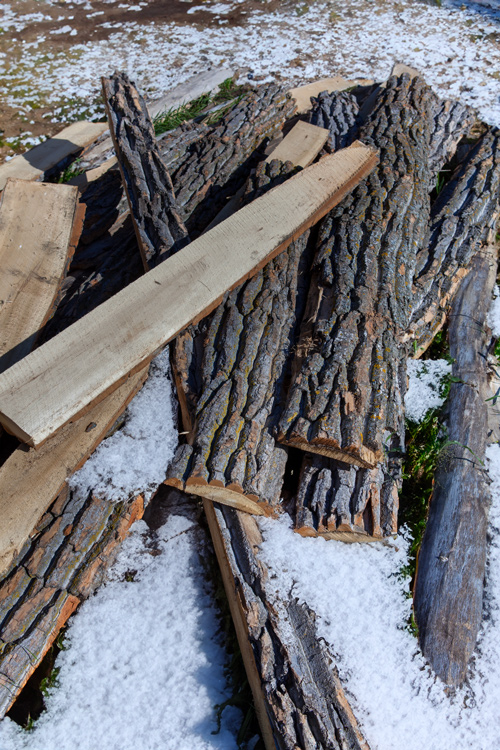The day is spent raising Fort Mandan cabins and splitting boards for the cabin lofts. Mandan hunters report capturing 100 pronghorns, Clark‘s rheumatism continues, and Lewis spends the day writing.
In St. Louis, Major Bruff—the Army Commandant of the Department of Upper Louisiana—shares rumors about the Lewis and Clark Expedition.
More About Sacagawea
by Yellowstone Public Radio[1]Originally aired weekdays by Yellowstone Public Radio during the Bicentennial observance of 2003-2006. Narrated by Hal Hansen. Scripts by Whit Hansen and Ed Jacobson. Produced by Leni Holliman. © … Continue reading
Cottonwood Puncheon
Taken with cooperation from the Fort Mandan Visitors’ Center. Photo © 2013 by Kristopher K. Townsend. Permission to use granted under the Creative Commons Attribution-Share Alike 4.0 International license.
Raising Huts
all hands to work eairly raiseing the other line of our huts & Splitting out punchiens for to lay the loft which we intend covering over with earth in order to make the huts more warm and comfortable. we dug a vault [latrine] 100 yds abo. the huts to make or keep the place healthy.
—John Ordway
Trapping Pronghorns
great numbers of Indians pass to and from hunting a Camp of Mandans, A fiew miles below us Cought within two days 100 Goat [pronghorns], by Driveing them in a Strong pen, detected by a Bush fence widening from the pen &c.
—William Clark
Fort Mandan Miscellany
I have the Rhumitism verry bad, Cap Lewis writeing all Day— we are told by our interpeter that 4 Ossiniboin [Assiniboine] Indians, have arrived at the Camps of the Gross Venters [Hidatsas] & 50 Lodges are Comeing
—William Clark
Jealousies and Rumors
In St. Louis, the Army Commandant of the Department of Upper Louisiana, James Bruff, tells his superior, James Wilkinson, of the jealousies aroused by recent Osage delegations. He also shares an alarming rumor.
St. Louis—U. Louisiana. November 5. 1804.
Sir.
. . . . .
The Osage chiefs left . . . loaded with valuable presents & puffed up with ideas of their great superiority to other nations . . . . But this has excited the jealousy & hatred of the other nations such a degree that I am apprehensive of the consequence . . . .
No News since the 4. August from Capts. Lewis & Clark—they were then at the mouth of the river Platt where two of their boatmen deserted: and it is reported by several Canadians who happened there at that time, that the others were much dissatisfied & complained of too regid a discipline. I am not, however, disposed to give full credit to their story. as they report other unfavourable circumstances that cannot be true:—such as a difference between the Captains &c.
J. Bruff Majr. Arty.[2]Letters of the Lewis and Clark Expedition with Related Documents: 1783-1854, 2nd ed., ed. Donald Jackson (Urbana: University of Illinois Press, 1978), 215.
Weather Diary
Ther. at rise
Weather Wind at rise
Thert. at 4 P.M. Weather Wind at 4 P.M. 30 cloudy N. W 58 Cloudy N W drew Mr. Gravlins [Joseph Gravelines] instructions &c. and discharged two of my hands
—Meriwether Lewis[3]To assist the reader, the editor of this web page has omitted the “day of the month” and “River Feet” columns and spelled out some abbreviations.
Fort Mandan is a High Potential Historic Site along the Lewis and Clark National Historic Trail managed by the U.S. National Park Service. The North Dakota Department of Parks and Recreation manages a modern reconstruction and the Lewis and Clark Interpretive Center located at US Hwy 83 and ND Hwy 200A.
Knife River Indian Villages National Historic Site is a High Potential Historic Site along the Lewis and Clark National Historic Trail managed by the U.S. National Park Service. A unit of the National Park System, the site is located at 564 County Road 37, one-half mile north of Stanton, North Dakota. It has exhibits, trails, and a visitor center.
Notes
| ↑1 | Originally aired weekdays by Yellowstone Public Radio during the Bicentennial observance of 2003-2006. Narrated by Hal Hansen. Scripts by Whit Hansen and Ed Jacobson. Produced by Leni Holliman. © 2003 by Yellowstone Public Radio. |
|---|---|
| ↑2 | Letters of the Lewis and Clark Expedition with Related Documents: 1783-1854, 2nd ed., ed. Donald Jackson (Urbana: University of Illinois Press, 1978), 215. |
| ↑3 | To assist the reader, the editor of this web page has omitted the “day of the month” and “River Feet” columns and spelled out some abbreviations. |
Experience the Lewis and Clark Trail
The Lewis and Clark Trail Experience—our sister site at lewisandclark.travel—connects the world to people and places on the Lewis and Clark Trail.
Discover More
- The Lewis and Clark Expedition: Day by Day by Gary E. Moulton (University of Nebraska Press, 2018). The story in prose, 14 May 1804–23 September 1806.
- The Lewis and Clark Journals: An American Epic of Discovery (abridged) by Gary E. Moulton (University of Nebraska Press, 2003). Selected journal excerpts, 14 May 1804–23 September 1806.
- The Lewis and Clark Journals. by Gary E. Moulton (University of Nebraska Press, 1983–2001). The complete story in 13 volumes.




